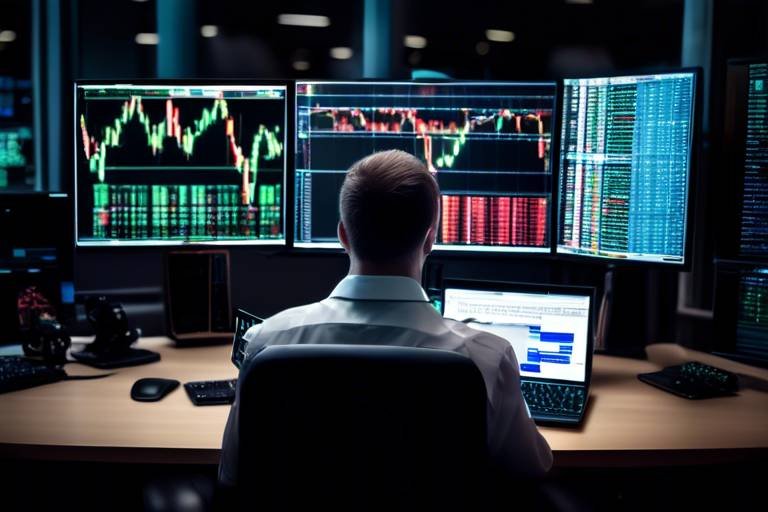Using News to Gauge Market Reactions
In the fast-paced world of finance, understanding how news impacts market behavior is crucial for traders and investors alike. With the constant flow of information, it can often feel overwhelming to decipher which news events will influence market movements and how. This article explores the intricate relationship between news and market reactions, shedding light on the key factors that drive these dynamics. From economic indicators to geopolitical events, we'll examine how different types of news can trigger significant shifts in market sentiment, investor behavior, and ultimately, price movements. By the end of this exploration, you'll gain valuable insights into the methodologies for effectively interpreting market reactions and how to leverage this knowledge in your trading strategies.
Economic news releases, such as Gross Domestic Product (GDP) figures and unemployment rates, play a pivotal role in shaping market reactions. Traders often look to these indicators as a gauge of economic health and future performance. For instance, a higher-than-expected GDP growth rate can lead to a surge in stock prices, as investors anticipate increased corporate profits. Conversely, disappointing unemployment figures might trigger a sell-off, as fears of economic downturn loom. Understanding how to interpret these indicators is vital for making informed trading decisions. Traders must stay alert to the timing of these releases, as markets can react swiftly, often within minutes, to the news. A well-timed trade can capitalize on these fleeting moments of volatility.
Understanding market sentiment is crucial for gauging reactions to news. Market sentiment refers to the overall attitude of investors toward a particular security or financial market. It can be influenced by a variety of factors, including news events, economic indicators, and even social media trends. When positive news is released, such as a breakthrough in technology or favorable economic data, investor sentiment typically shifts toward optimism, leading to increased buying activity. On the flip side, negative news can create fear and uncertainty, prompting investors to sell off their holdings. This psychological aspect of trading is what makes market sentiment analysis so important. It’s like reading the mood of a crowd at a concert—understanding whether the audience is energized or anxious can provide insights into potential market movements.
Behavioral finance offers a fascinating lens through which to view market reactions to news. It delves into the psychological factors that influence investor behavior, highlighting how cognitive biases can lead to irrational decision-making. For instance, the overreaction theory suggests that investors often respond too strongly to new information, causing prices to swing dramatically in the short term. Similarly, herd behavior illustrates how individuals tend to follow the crowd, leading to amplified market movements based on collective sentiment rather than rational analysis. Understanding these behavioral finance theories equips traders with the knowledge to anticipate potential market overreactions and capitalize on them effectively.
One of the most intriguing aspects of market behavior is the tendency for investors to overreact to news events. This phenomenon can lead to significant volatility in the markets, as seen in historical examples like the dot-com bubble or the 2008 financial crisis. During these periods, news events triggered extreme reactions, often resulting in sharp price movements that didn't necessarily reflect the underlying fundamentals. For traders, recognizing these patterns can be a double-edged sword—while overreactions can present lucrative trading opportunities, they also come with heightened risks. Thus, a keen awareness of market psychology and historical precedents is essential for navigating these turbulent waters.
Herd behavior plays a substantial role in amplifying market reactions to news. When investors observe others buying or selling based on a news event, they often feel compelled to follow suit, regardless of their independent analysis. This collective decision-making can create a feedback loop, where the initial reaction to news spirals into larger market movements. In today's digital age, social media has intensified this effect, allowing news to spread rapidly and influencing a broader audience almost instantaneously. It's akin to a wildfire—once it starts, it can quickly engulf everything in its path. Understanding the role of herd behavior is crucial for traders looking to navigate these market dynamics effectively.
To quantify the impact of news on markets, traders often turn to quantitative analysis. This involves using statistical models and tools to measure how specific news events influence market prices and investor behavior. By analyzing historical data, traders can identify patterns and correlations that help predict future market reactions. For example, regression models can be employed to assess the relationship between economic news releases and stock price movements. This data-driven approach allows traders to make informed decisions based on empirical evidence rather than speculation, enhancing their chances of success in a volatile environment.
Different types of news can trigger varying market responses, and understanding these categories is essential for effective trading. Here are some key types of news that significantly impact market dynamics:
- Political News: Changes in government policy or political instability can lead to uncertainty in markets.
- Corporate News: Earnings reports, mergers, and acquisitions can directly influence stock performance.
- Global Events: Natural disasters, pandemics, or international relations can create ripple effects across global markets.
Corporate earnings reports are critical indicators for stock performance. These reports provide insights into a company's financial health and future prospects. A company that exceeds earnings expectations may see its stock price soar, while disappointing results can lead to sharp declines. Investors closely analyze these reports, looking for clues about a company's growth trajectory and market position. Understanding how to interpret these earnings releases is vital for making informed trading decisions and capitalizing on market movements.
Geopolitical events can create uncertainty in markets, often leading to increased volatility. Political instability, trade disputes, or military conflicts can all affect investor confidence and market trends. For instance, tensions between countries can lead to fluctuations in commodity prices, while changes in trade policies can impact global supply chains. Traders must stay informed about geopolitical developments and their potential implications for market dynamics. It's like navigating a ship through a storm—being aware of your surroundings can help you avoid potential pitfalls.
Traders employ various strategies to capitalize on news-driven market movements. Effective trading techniques and risk management practices are essential for navigating these volatile markets. By understanding how to leverage news events, traders can position themselves for success.
News trading strategies focus on exploiting market inefficiencies that arise from news releases. Techniques such as straddle strategies, where traders buy both call and put options to capture price movements around news events, are commonly employed. These strategies allow traders to profit from volatility, regardless of the direction the market moves. However, timing is crucial, as markets can react swiftly to news, and being prepared can make all the difference.
Effective risk management is essential when trading on news. Techniques such as setting stop-loss orders, diversifying portfolios, and maintaining a disciplined approach can help mitigate risks associated with sudden market shifts triggered by news events. Traders must remain vigilant and adaptable, as the market landscape can change rapidly based on new information. By implementing sound risk management practices, traders can navigate the complexities of news-driven markets with greater confidence.
Q: How does news impact stock prices?
A: News can significantly influence stock prices by shaping investor sentiment and expectations. Positive news often leads to increased buying activity, while negative news can trigger sell-offs.
Q: What are some common types of news that affect markets?
A: Common types of news include economic indicators, corporate earnings reports, political news, and geopolitical events.
Q: How can traders prepare for news releases?
A: Traders can prepare by staying informed about upcoming news events, analyzing historical data, and developing trading strategies that account for potential market reactions.

The Impact of Economic News
Economic news releases play a pivotal role in shaping market reactions. Think about it: when the government announces a rise in GDP or a dip in unemployment rates, traders and investors are like hawks, ready to swoop in and react. These indicators are not just numbers; they are the pulse of the economy, reflecting its health and predicting future trends. For instance, a robust GDP growth rate often leads to bullish market sentiment, while disappointing unemployment figures can trigger panic selling. This is because investors constantly seek signals that may affect their investments, and economic news is one of the most significant sources of such signals.
When traders digest economic reports, they often look for trends and patterns that can indicate future market movements. For example, if a country reports a steady increase in jobs, it usually suggests a growing economy, which can lead to increased consumer spending. This, in turn, can boost corporate earnings and, thus, stock prices. Conversely, negative economic news can create a ripple effect, causing uncertainty and hesitation among investors. They might start questioning their investment strategies, leading to increased volatility in the markets.
To better understand the impact of economic news, let's break it down into a few key categories:
- Gross Domestic Product (GDP): A primary indicator of economic health, GDP measures the total value of goods and services produced over a specific time period. An increase in GDP typically signals growth, while a decrease can indicate economic trouble.
- Unemployment Rates: High unemployment rates can lead to decreased consumer spending, which negatively impacts businesses and the stock market. Conversely, low unemployment often correlates with a thriving economy.
- Inflation Rates: Inflation can erode purchasing power, affecting consumer behavior. Traders closely monitor inflation data, as rising prices can lead to interest rate hikes.
Moreover, the timing of these releases is critical. Economic news is often scheduled, creating a predictable rhythm in the markets. Traders prepare in advance, analyzing forecasts and adjusting their positions accordingly. This anticipation can lead to significant price movements even before the news is officially released. For instance, if analysts predict a positive jobs report, the stock market may rally in advance, reflecting the optimism of investors.
However, not all news is interpreted the same way. The context surrounding the news is equally important. For example, if a strong GDP report is released alongside rising inflation, the overall market reaction may be muted or even negative, as investors weigh the potential for interest rate increases against the positive economic growth. This complexity adds a layer of intrigue to market reactions, making it essential for traders to stay informed and agile.
In conclusion, economic news significantly influences market behavior, and understanding its impact is crucial for any trader or investor. By keeping an eye on key economic indicators and their implications, one can better navigate the often tumultuous waters of the financial markets.

Market Sentiment Analysis
Understanding market sentiment is crucial for gauging how news influences investor behavior. Market sentiment refers to the overall attitude of investors towards a particular security or financial market. It’s like the mood of the market—sometimes it's upbeat and optimistic, while at other times, it can be gloomy and pessimistic. This sentiment is often shaped by news events, ranging from economic indicators to corporate announcements, and it plays a significant role in driving market trends.
When significant news breaks, traders and investors react not just to the news itself, but also to how they believe others will react. This creates a ripple effect that can amplify price movements. For instance, if a major company announces a disappointing earnings report, investors may panic and sell off their shares, not just because of the news, but because they fear others will do the same. This phenomenon can lead to sharp declines in stock prices, often exaggerated by the collective emotions of investors.
To illustrate how news shapes market sentiment, let's consider a few key factors:
- Media Coverage: The way news is reported can significantly influence investor sentiment. Positive headlines can boost confidence, while negative coverage can instill fear.
- Social Media Influence: In today's digital age, social media plays a pivotal role in shaping perceptions. A single tweet can trigger widespread panic or excitement, impacting stock prices almost instantaneously.
- Economic Indicators: Reports on unemployment rates, inflation, and GDP growth can sway investor sentiment. For example, a sudden rise in unemployment may lead to fears of an economic downturn, prompting a sell-off.
Moreover, psychological factors come into play. Investors often exhibit behaviors driven by emotions rather than rational analysis. This is where behavioral finance theories come into the picture, helping us understand why market sentiment can sometimes deviate from fundamental values. Cognitive biases, such as overconfidence and loss aversion, can cloud judgment and lead to irrational trading decisions.
For example, during periods of market euphoria, investors might ignore warning signs and continue to buy into a rally, believing that prices will keep climbing. Conversely, during a downturn, fear can lead to panic selling, even if the underlying fundamentals remain strong. Such behaviors are not just individual reactions; they often reflect a broader market sentiment that can create trends.
In summary, market sentiment analysis is essential for understanding how news influences investor behavior. By recognizing the psychological factors at play and the impact of various types of news, traders can make more informed decisions. This understanding can help them navigate the often turbulent waters of the financial markets, capitalizing on opportunities while managing risks effectively.
- What is market sentiment? Market sentiment refers to the overall attitude of investors toward a particular security or financial market.
- How does news affect market sentiment? News can influence market sentiment by shaping perceptions and triggering emotional reactions among investors.
- What role does social media play in market sentiment? Social media can rapidly spread information (or misinformation), significantly impacting how investors feel about market conditions.

Behavioral Finance Theories
Behavioral finance is a fascinating field that blends psychology with traditional finance to explain why and how investors often make irrational decisions. It's like trying to decode a complex puzzle where emotions and cognitive biases play a significant role in shaping market reactions. Imagine you’re at a party, and everyone suddenly starts dancing to a catchy tune. You might feel compelled to join in, even if you didn’t plan to dance. This is similar to how herd behavior can influence market trends; when investors see others reacting to news, they often jump in without fully analyzing the situation.
One of the key theories in behavioral finance is the concept of overreaction. This occurs when investors respond too strongly to news, causing significant price swings that may not accurately reflect the underlying value of an asset. For instance, when a company announces lower-than-expected earnings, investors might panic and sell off their shares en masse, pushing the price down further than warranted. This overreaction can create opportunities for savvy investors who recognize that the fundamental value of the company hasn’t changed significantly.
Another important aspect of behavioral finance is herd behavior. This theory suggests that individuals often mimic the actions of a larger group, leading to collective decision-making that can amplify market movements. In today’s digital age, social media plays a crucial role in this phenomenon. News spreads rapidly, and when a large number of investors react to a piece of news, it can create a snowball effect. For example, during major geopolitical events, if a significant number of traders begin to sell off assets due to fear, it can lead to a market crash, regardless of the actual economic fundamentals.
To illustrate these theories further, let’s take a look at a simplified table that summarizes some key behavioral finance concepts:
| Concept | Description |
|---|---|
| Overreaction | Investors respond excessively to news, leading to price fluctuations that do not reflect true asset value. |
| Herd Behavior | Investors follow the crowd, often leading to irrational market trends and collective decision-making. |
| Anchoring | Investors rely too heavily on the first piece of information they receive, affecting their future decisions. |
| Loss Aversion | Investors prefer to avoid losses rather than acquiring equivalent gains, leading to overly cautious behavior. |
Understanding these behavioral finance theories is essential for traders and investors alike. By recognizing that emotions and psychological factors can drive market behavior, individuals can better navigate the complexities of investing. It’s like having a map in a dense forest; it helps you find your way through the chaos. So, the next time you see a significant market movement following a news event, take a moment to consider not just the facts, but also the emotional undercurrents that may be at play.
- What is behavioral finance? Behavioral finance studies how psychological factors and cognitive biases influence investor behavior and market outcomes.
- How does overreaction affect the stock market? Overreaction can lead to excessive price movements that do not accurately reflect the underlying value of assets, creating volatility.
- What is herd behavior in investing? Herd behavior occurs when investors follow the actions of others, often leading to irrational market trends.
- Can understanding behavioral finance improve my trading? Yes, by recognizing psychological biases, traders can make more informed decisions and potentially capitalize on market inefficiencies.

Overreaction to News Events
When it comes to financial markets, the phenomenon of overreaction to news events is a captivating and often alarming reality. Investors, fueled by emotions and cognitive biases, frequently respond to news with a level of intensity that far exceeds the actual significance of the information being reported. This overreaction can lead to dramatic fluctuations in stock prices, creating opportunities for savvy traders while simultaneously posing risks for those caught in the frenzy.
One classic example of this overreaction can be seen during earnings season, when companies release their quarterly financial results. A company that posts earnings slightly below analyst expectations may see its stock price plummet, even if the overall business remains fundamentally strong. This response often stems from a combination of fear and the herd mentality, where investors rush to sell in panic, driving the price down further. Conversely, positive news can spark euphoric buying, pushing prices to unsustainable highs.
The psychological factors at play are significant. Investors often fall prey to confirmation bias, where they seek out information that supports their preconceived notions, ignoring contradictory evidence. This behavior can exacerbate price swings as traders react impulsively to news that aligns with their beliefs. As a result, the market can become disconnected from the underlying value of assets, leading to what some analysts refer to as "market bubbles."
To illustrate this concept, consider the following table that highlights historical instances of overreaction in the markets:
| Event | Market Reaction | Aftermath |
|---|---|---|
| 2008 Financial Crisis | Massive sell-off across all sectors | Prolonged recession, followed by recovery |
| Brexit Vote (2016) | Immediate drop in UK stocks | Market stabilization after initial shock |
| COVID-19 Pandemic Announcement | Sharp decline in global markets | Subsequent recovery driven by stimulus measures |
These instances serve as reminders that while news can certainly influence market dynamics, it is crucial for investors to maintain a level-headed approach. Understanding the potential for overreaction can help traders avoid getting swept up in the emotional tide and instead focus on sound investment principles. By adopting a more analytical mindset, traders can better navigate the volatility that often accompanies significant news events.
In conclusion, recognizing the tendency for overreaction in response to news events is vital for anyone involved in the financial markets. By being aware of the psychological triggers at play and the historical context of market reactions, investors can make more informed decisions and potentially capitalize on the opportunities that arise from these dramatic price movements.
- What causes overreaction in financial markets? Overreaction is often driven by emotional responses, cognitive biases, and herd behavior among investors.
- How can investors avoid falling into the overreaction trap? Investors can mitigate the risk of overreacting by conducting thorough research, maintaining a long-term perspective, and avoiding impulsive decisions based on short-term news.
- Are there strategies to profit from market overreactions? Yes, traders can implement strategies such as contrarian investing or using options to hedge against volatility during news events.

Herd Behavior in Markets
Herd behavior in financial markets is a fascinating phenomenon that can lead to dramatic price movements and significant volatility. Imagine a flock of birds taking off at once; they don’t all decide independently to fly away; instead, they follow the lead of others. Similarly, in trading, when investors observe a surge in buying or selling activity, they often feel compelled to join in, fearing they might miss out on potential profits or wanting to avoid losses. This collective decision-making process can amplify market reactions to news, creating a ripple effect that can be both exhilarating and perilous.
One of the most striking aspects of herd behavior is how it can distort rational decision-making. Instead of analyzing the fundamentals of an investment, traders may react impulsively to the actions of others. For example, during a market downturn, if a significant number of investors start selling off their stocks, others may panic and follow suit, leading to a further decline. This phenomenon can create a vicious cycle that results in a market crash, as seen during the 2008 financial crisis. In contrast, during a market rally, the enthusiasm can be infectious, causing more investors to jump in, often driving prices to unsustainable levels.
Social media plays a pivotal role in amplifying herd behavior. With the rise of platforms like Twitter and Reddit, news spreads at lightning speed, and traders can react almost instantaneously. A single tweet from a high-profile investor or a trending topic can ignite a buying frenzy or a sell-off, often before the actual news has been fully digested. The viral nature of information on social media means that traders are not just influenced by traditional news outlets but also by the opinions and actions of their peers, which can lead to herd behavior that is even more pronounced.
To better understand the impact of herd behavior, let’s take a look at some key characteristics:
| Characteristic | Description |
|---|---|
| Imitation | Investors mimic the actions of others, often disregarding their own analysis. |
| Fear of Missing Out (FOMO) | Investors rush to buy or sell based on the fear that they might miss a profitable opportunity. |
| Overconfidence | When many investors are acting in unison, it can lead to a false sense of security about market trends. |
| Market Volatility | Herd behavior can lead to sharp price fluctuations, creating a more volatile market environment. |
In conclusion, understanding herd behavior is crucial for investors looking to navigate the complexities of the market. Recognizing when emotions are driving decisions rather than rational analysis can provide a significant advantage. By staying informed, maintaining a level head, and not succumbing to the pressure of the crowd, investors can make more informed decisions and potentially avoid the pitfalls of herd mentality.
- What is herd behavior in financial markets? Herd behavior refers to the tendency of investors to follow the actions of others, often leading to irrational and volatile market movements.
- How does social media influence herd behavior? Social media accelerates the spread of news and opinions, causing traders to react quickly and often impulsively to trends.
- Can herd behavior lead to market crashes? Yes, herd behavior can exacerbate market downturns as panic selling can create a downward spiral in prices.
- How can investors protect themselves from herd behavior? Investors can mitigate the effects of herd behavior by conducting thorough research, sticking to their trading strategies, and avoiding impulsive decisions based on market sentiment.

Quantitative Analysis of News Impact
When it comes to understanding how news affects market behavior, quantitative analysis serves as a powerful tool. By employing statistical methods and data-driven models, traders and analysts can measure the impact of specific news events on market prices. This approach allows for a more objective interpretation of market reactions, moving beyond the subjective interpretations that can often cloud decision-making. For instance, analysts might use regression models to evaluate how a particular economic report correlates with stock price movements over time. This method not only helps in identifying patterns but also in predicting future market behavior based on historical data.
One of the most common methodologies in quantitative analysis is the use of event studies. An event study assesses the impact of a specific event—like a corporate earnings release or a significant geopolitical announcement—on the price of a stock or a market index. By analyzing the stock's performance over a defined period before and after the event, analysts can determine whether the news had a statistically significant impact. This is often represented in a table format that showcases the abnormal returns surrounding the event date, giving traders a clear visual representation of market reactions.
| Event Date | Stock Price Before Event | Stock Price After Event | Abnormal Return |
|---|---|---|---|
| 2023-01-15 | $100 | $110 | +10% |
| 2023-02-20 | $95 | $85 | -10% |
| 2023-03-30 | $120 | $125 | +4.17% |
Another critical aspect of quantitative analysis is sentiment analysis, which involves analyzing news articles, social media posts, and other textual data to gauge market sentiment. By using natural language processing (NLP) algorithms, traders can quantify the sentiment expressed in news headlines and reports. This can provide insights into how positively or negatively news is perceived by the market, which can be a leading indicator of price movements. For example, if a major news outlet publishes a series of positive articles about a tech company, the sentiment score derived from these articles can help predict an upward trend in the stock price.
Moreover, quantitative models can incorporate various factors such as trading volume, volatility, and macroeconomic indicators to create a more comprehensive analysis. The integration of machine learning techniques can further enhance these models, allowing them to adapt to new data and improve predictive accuracy over time. As markets evolve, so too must the tools we use to analyze them, making quantitative analysis an essential component of modern trading strategies.
- What is quantitative analysis in trading?
Quantitative analysis in trading involves using mathematical and statistical models to evaluate the impact of various factors, including news events, on market prices. It helps traders make data-driven decisions rather than relying solely on intuition. - How can I measure the impact of news on stock prices?
You can measure the impact of news on stock prices through event studies, which analyze stock performance before and after news events to determine abnormal returns. - What role does sentiment analysis play in quantitative trading?
Sentiment analysis helps traders understand how news is perceived by the market. By quantifying sentiment from news articles and social media, traders can anticipate market movements based on public perception.

Types of News Affecting Markets
In the dynamic world of finance, news serves as a critical catalyst that can ignite market movements or calm turbulent waters. Understanding the types of news that can affect market behavior is essential for traders and investors alike. These news types can be broadly categorized into several categories, each with its unique implications for market dynamics.
First and foremost, economic news plays a pivotal role in shaping market reactions. Reports on gross domestic product (GDP), unemployment rates, inflation, and consumer spending provide insights into the overall health of the economy. For instance, a surprising increase in GDP can lead to bullish market sentiment, while disappointing unemployment figures may trigger a sell-off. The market's interpretation of these indicators often hinges on investor expectations and the broader economic context.
Next, we have corporate news, which is particularly relevant for stock markets. Earnings reports, product launches, and management changes can significantly impact a company's stock price. For example, a company that reports earnings exceeding analyst expectations may see its stock soar, while a missed earnings forecast could lead to a sharp decline. Traders often analyze these reports closely, looking for trends and signals that could indicate future performance.
Then, there are geopolitical events, which can create waves of uncertainty in the markets. Events such as elections, trade negotiations, and international conflicts can lead to volatility as investors react to potential risks. For instance, a sudden escalation in trade tensions between two major economies can lead to fears of a global economic slowdown, prompting market sell-offs. Understanding the implications of these events requires not only knowledge of the facts but also an awareness of how they influence investor sentiment.
Additionally, global events like natural disasters, pandemics, or significant technological advancements can also sway market behavior. The COVID-19 pandemic, for example, had a profound impact on global markets, causing unprecedented volatility as investors grappled with uncertainty about economic recovery. Such events remind us that the interconnectedness of the global economy means that news from one part of the world can reverberate across markets everywhere.
To summarize, the types of news that can affect markets are diverse and multifaceted. From economic indicators to corporate announcements and geopolitical developments, each type of news carries the potential to influence investor sentiment and market behavior. Understanding these nuances is crucial for anyone looking to navigate the complex landscape of financial markets effectively.
- What types of economic news should traders pay attention to?
Traders should focus on key indicators such as GDP growth, unemployment rates, inflation data, and consumer confidence reports. - How do corporate earnings reports affect stock prices?
Earnings reports provide insights into a company's financial health, and exceeding or missing analyst expectations can lead to significant price movements. - Why are geopolitical events important for market reactions?
Geopolitical events can create uncertainty and risk, prompting investors to reassess their positions and leading to market volatility. - Can global events impact local markets?
Yes, global events can have a ripple effect, influencing local market sentiment and trading behavior due to the interconnected nature of the global economy.

Corporate Earnings Reports
When it comes to understanding the stock market, are like the pulse of a company. These reports provide a snapshot of a company's financial health, detailing its revenue, expenses, and profit margins over a specific period. Investors and traders alike eagerly await these reports because they can significantly influence stock prices, often leading to dramatic market reactions. Imagine a rollercoaster ride; the anticipation builds as the earnings release date approaches, and the outcome can send stocks soaring or plummeting, depending on whether the results meet, exceed, or fall short of expectations.
Typically, earnings reports are released on a quarterly basis, and they contain essential metrics that investors scrutinize. Some of the key figures include:
- Revenue: The total income generated from sales before any expenses are deducted.
- Net Income: The profit remaining after all expenses, taxes, and costs have been subtracted from total revenue.
- Earnings Per Share (EPS): A measure of a company's profitability on a per-share basis, which is a critical indicator for investors.
- Guidance: Future earnings expectations provided by the company's management, which can significantly sway investor sentiment.
But why do these reports matter so much? Well, they serve as a barometer of a company's performance relative to its competitors and the overall market. A strong earnings report can signal a healthy business, prompting investors to buy in, while a disappointing report can trigger panic selling. For instance, let’s consider two companies in the tech sector:
| Company | Q1 Earnings Report | Market Reaction |
|---|---|---|
| TechCorp | Revenue: $10M, EPS: $1.50 | Stock price rose by 15% |
| GigaTech | Revenue: $8M, EPS: $0.50 | Stock price fell by 20% |
As seen in the table, TechCorp's robust earnings led to a surge in its stock price, while GigaTech's underwhelming results caused a significant drop. This example illustrates how earnings reports can create a ripple effect across the market, influencing not just the companies involved but also their competitors and the broader industry.
Moreover, the timing of these reports can also play a crucial role. Companies that release their earnings before market opening or after hours can experience different levels of volatility compared to those that report during trading hours. For traders, this means that understanding the nuances of earnings reports is vital for making informed decisions. The emotional rollercoaster of trading around earnings can be exhilarating, but it also comes with risks that need to be managed carefully.
In conclusion, corporate earnings reports serve as a critical tool for investors and traders alike. They provide valuable insights into a company's performance, shape market expectations, and can lead to significant price movements. As a trader, staying informed about upcoming earnings releases and understanding the implications of these reports can be the difference between a profitable trade and a costly mistake.

Geopolitical Events
Geopolitical events are like the wildcards of the market; they can create waves of uncertainty that ripple through financial landscapes. When tensions rise between nations, or when significant political changes occur, the market often reacts with a mix of fear and speculation. Think of it this way: just as a sudden storm can disrupt a calm sea, geopolitical tensions can shake investor confidence and lead to unpredictable market behavior.
For instance, consider how conflicts in oil-rich regions can send crude oil prices soaring. Investors, reacting to the potential for supply disruptions, might rush to buy oil stocks, causing a spike in prices. This reaction is not just about the immediate impact; it reflects deeper psychological factors at play. When investors perceive a threat, they often act quickly, sometimes making decisions based more on emotion than on rational analysis.
To illustrate the impact of geopolitical events, let’s look at a few key factors that typically influence market reactions:
- Political Stability: Countries with stable governments tend to attract more foreign investment, while instability can lead to capital flight.
- Trade Relations: Tariffs, trade agreements, and sanctions can significantly impact market dynamics, particularly for companies reliant on international trade.
- Military Conflicts: Wars and military actions can disrupt supply chains and create volatility in sectors like energy and defense.
Moreover, the role of media cannot be overstated. In today’s digital age, news spreads like wildfire, and social media amplifies the effects of geopolitical events. A single tweet from a world leader can send markets tumbling or soaring within minutes. Therefore, traders must stay informed and be ready to react to the latest developments, making the ability to interpret news accurately more crucial than ever.
In summary, geopolitical events are a significant driver of market reactions. They not only influence immediate price movements but also shape long-term investor sentiment. Understanding the nuances of these events can provide traders with a competitive edge, allowing them to navigate the turbulent waters of the financial markets effectively.
1. How do geopolitical events affect stock prices?
Geopolitical events can lead to uncertainty, causing investors to either buy or sell stocks based on perceived risks. For instance, if a country faces political turmoil, investors may fear for the stability of companies operating there, leading to a drop in stock prices.
2. What role does media play in market reactions to geopolitical events?
Media plays a critical role by disseminating information quickly. With the rise of social media, news about geopolitical events can spread rapidly, often leading to immediate reactions in the market as investors respond to the latest headlines.
3. Can geopolitical events create long-term market trends?
Yes, prolonged geopolitical tensions can lead to long-term trends, as investors adjust their expectations and strategies based on the evolving landscape. For example, ongoing trade wars can reshape entire industries over time.

Strategies for Trading on News
Trading on news can feel like riding a roller coaster—exhilarating yet terrifying! To make the most of this thrilling experience, traders need to adopt effective strategies that can help them navigate the unpredictable waters of market reactions. One of the most popular approaches is the news trading strategy, which focuses on capitalizing on the price movements triggered by significant news events. This strategy involves analyzing the news and predicting how it will impact market prices, allowing traders to position themselves advantageously.
For instance, traders often utilize straddle strategies around major news releases. This involves placing both a buy and a sell order at certain price points, anticipating that the market will move sharply in one direction or the other following the news. The idea is to capture profits from the volatility that typically ensues after an announcement, whether it’s a positive earnings report or unexpected economic data. However, it’s crucial to keep in mind that while this strategy can lead to substantial gains, it can also result in losses if the market doesn’t react as anticipated.
Another effective technique involves risk management. This is where the savvy trader distinguishes themselves from the rest. When trading on news, the potential for sudden price swings is heightened, making risk management essential. Techniques such as setting stop-loss orders can help mitigate losses if the market doesn’t move in the desired direction. Additionally, traders should consider their overall portfolio exposure and avoid putting all their capital into a single trade based on news, as this can lead to devastating losses.
To further enhance their trading strategies, many traders also rely on technical analysis. By examining historical price movements and patterns, traders can gain insights into how similar news events have affected the market in the past. This analysis can help them develop a more informed outlook on potential future movements, allowing them to make better trading decisions. For example, if a company consistently sees its stock price rise after earnings reports, a trader might decide to buy before the next report, anticipating a similar reaction.
Ultimately, successful news trading requires a blend of quick thinking, solid strategy, and a dash of intuition. Traders must be ready to adapt their strategies in real-time, as market conditions can shift rapidly in response to breaking news. By staying informed, managing risks effectively, and employing well-thought-out strategies, traders can harness the power of news to their advantage, turning potential chaos into opportunity.
- What is news trading? News trading involves making trades based on the impact of news events on market prices.
- How can I manage risks when trading on news? You can manage risks by using stop-loss orders and diversifying your portfolio to avoid heavy losses.
- What are straddle strategies? Straddle strategies involve placing both buy and sell orders to capitalize on expected volatility after news releases.
- Is technical analysis useful in news trading? Yes, technical analysis helps traders understand historical market reactions to news, aiding in better decision-making.

News Trading Strategies
When it comes to navigating the unpredictable waters of the financial markets, can be a game changer. These strategies are designed to help traders capitalize on the rapid price movements that often follow significant news releases. Imagine standing on the edge of a cliff, feeling the rush of wind as a storm approaches; that's the kind of adrenaline and opportunity that news trading can provide. However, just like a storm, it requires careful preparation and understanding to harness its power without getting swept away.
One of the most popular approaches in news trading is the straddle strategy. This involves placing both a buy and a sell order around a news event, anticipating a significant price movement in either direction. Think of it as setting up a safety net; you’re ready for whatever outcome unfolds. This strategy works best during high-impact news events, such as central bank announcements or major economic indicators, where volatility is expected. Traders often look at the economic calendar to identify these key events and plan their trades accordingly.
Another effective method is the breakout strategy. In this case, traders watch for price levels to break through significant support or resistance after a news release. When the news is released, and the price breaks out of its established range, it can lead to substantial movements. Traders can set their entry points just above resistance or below support, allowing them to ride the wave of momentum. However, caution is essential; not all breakouts lead to sustained movements, and false breakouts can lead to losses.
Moreover, understanding the market sentiment surrounding a news event is crucial. Traders often analyze social media, news articles, and forums to gauge how the broader market perceives the news. For instance, if a corporate earnings report beats expectations, but the overall sentiment remains negative due to broader economic concerns, the stock may not react as bullishly as anticipated. This is where a keen sense of intuition and analysis can separate successful traders from the rest.
To illustrate the effectiveness of these strategies, let's take a look at a hypothetical scenario:
| News Event | Expected Impact | Strategy Used | Outcome |
|---|---|---|---|
| Central Bank Rate Decision | High Volatility | Straddle Strategy | Profitable due to significant price movement |
| Corporate Earnings Report | Moderate Volatility | Breakout Strategy | Loss due to false breakout |
| Unemployment Rate Release | High Volatility | Market Sentiment Analysis | Profitable with accurate sentiment prediction |
In addition to these strategies, effective risk management techniques are paramount. Setting stop-loss orders can help protect your capital from sudden market reversals. Moreover, it’s essential to avoid over-leveraging, as the allure of quick profits can sometimes cloud judgment. Just like a seasoned sailor understands the importance of a sturdy ship, a successful trader knows that a solid risk management plan is vital to weathering the storms of volatility.
In conclusion, while news trading strategies can provide lucrative opportunities, they require a blend of skill, analysis, and discipline. By employing a variety of methods and maintaining a keen awareness of market sentiment, traders can position themselves to ride the waves of market reactions effectively. So, are you ready to take the plunge into the thrilling world of news trading?
- What is news trading? News trading involves making trades based on the impact of news events on market prices.
- What are some common news trading strategies? Popular strategies include straddle, breakout, and sentiment analysis.
- How can I manage risk while trading on news? Use stop-loss orders, avoid over-leveraging, and ensure proper position sizing.
- What types of news events should I watch for? Focus on economic indicators, corporate earnings reports, and geopolitical events.

Risk Management Techniques
When it comes to trading on news, one of the most crucial aspects that can make or break your success is risk management. Think of it as your safety net; without it, you might find yourself tumbling down the rabbit hole of market volatility. So, how can traders effectively manage risks associated with sudden market shifts triggered by news events? Let's dive into some key techniques that can help you navigate these turbulent waters.
First and foremost, setting stop-loss orders is essential. These orders automatically sell your position when it reaches a certain price, limiting your potential loss. Imagine you're on a roller coaster; you wouldn’t want to go over the edge, right? A stop-loss order is like that safety harness, ensuring you don’t fall into a pit of despair when the market takes an unexpected plunge.
Another effective technique is the use of position sizing. This involves determining how much capital to allocate to each trade based on your overall portfolio size and risk tolerance. Think of it like portion control at a buffet; you wouldn’t want to pile your plate too high and regret it later. By carefully sizing your positions, you can mitigate the impact of any single trade on your overall portfolio.
Additionally, employing a diversification strategy can be a game changer. By spreading your investments across various assets, sectors, or geographical regions, you reduce the risk of a significant loss from any one source. It’s akin to having multiple streams of income; if one dries up, you still have others to rely on. This technique can cushion the blow when unexpected news sends shockwaves through specific markets.
Moreover, it’s essential to stay informed and keep an eye on the economic calendar. Knowing when major news releases are scheduled allows you to prepare your strategy in advance. It’s like studying for an exam; the more you know about what to expect, the less likely you are to be caught off guard. By anticipating market-moving events, you can adjust your positions accordingly and minimize potential risks.
Lastly, consider utilizing trailing stops. This technique allows you to lock in profits while still giving your trade room to grow. A trailing stop moves with the market price, so if the market turns against you, your position will close at a predetermined level. It’s like having a safety net that adjusts as you soar higher, ensuring you can safely land without losing all your gains.
In conclusion, effective risk management techniques are vital in the unpredictable world of news-driven trading. By implementing strategies such as stop-loss orders, position sizing, diversification, staying informed, and using trailing stops, traders can better navigate the choppy waters of market volatility. Remember, it’s not just about making profits; it’s about protecting what you have worked hard to earn.
- What is risk management in trading? Risk management in trading refers to the strategies and techniques used to minimize potential losses and protect capital during market fluctuations.
- How do stop-loss orders work? Stop-loss orders automatically sell a security when it reaches a specified price, helping to limit losses on a trade.
- Why is diversification important? Diversification helps reduce risk by spreading investments across various assets, which can cushion the impact of losses from any single investment.
- What is a trailing stop? A trailing stop is a type of stop-loss order that moves with the market price, allowing traders to lock in profits while still giving their trades room to grow.
Frequently Asked Questions
- How does economic news impact market reactions?
Economic news, such as GDP growth and unemployment rates, plays a pivotal role in shaping market reactions. Traders closely monitor these indicators because they provide insights into the health of an economy. For instance, a stronger-than-expected GDP report may lead to a bullish market sentiment, while disappointing unemployment figures can trigger sell-offs. Understanding these dynamics can help investors make informed decisions.
- What is market sentiment and why is it important?
Market sentiment refers to the overall attitude of investors toward a particular market or asset. It's crucial because it influences price movements and can lead to significant volatility. When news breaks, it can shift sentiment rapidly, causing investors to react emotionally rather than logically. By gauging market sentiment, traders can better anticipate potential market reactions and adjust their strategies accordingly.
- What are some common behavioral finance theories related to news reactions?
Behavioral finance theories, such as overreaction and herd behavior, explain how psychological factors affect investor decisions. Overreaction occurs when investors respond too strongly to news, leading to excessive price swings. Herd behavior, on the other hand, describes how individuals tend to follow the crowd, amplifying market trends. These theories highlight the importance of understanding human psychology in trading.
- What types of news have the most significant impact on markets?
Several types of news can significantly influence market dynamics, including economic reports, corporate earnings announcements, and geopolitical events. For example, a company's earnings report can directly affect its stock price, while geopolitical tensions can create widespread uncertainty, impacting overall market confidence. Being aware of these news types can help traders anticipate market movements.
- How can traders effectively capitalize on news-driven market movements?
Traders can employ various strategies to take advantage of news-driven market movements. One popular approach is news trading strategies, which focus on exploiting market inefficiencies that arise from unexpected news. Techniques like straddle strategies can be effective in capturing price movements around significant news releases. However, it's essential to combine these strategies with robust risk management practices to mitigate potential losses.
- What risk management techniques should traders use when trading on news?
Effective risk management is vital when trading on news, as markets can react unpredictably. Traders should consider using stop-loss orders to limit potential losses and diversify their portfolios to spread risk. Additionally, understanding the volatility of specific news events can help traders adjust their position sizes appropriately. By employing these techniques, traders can navigate the uncertainties that news events bring.



















